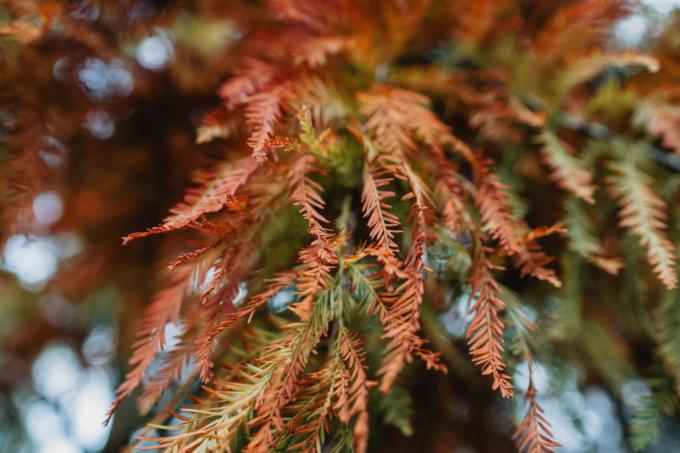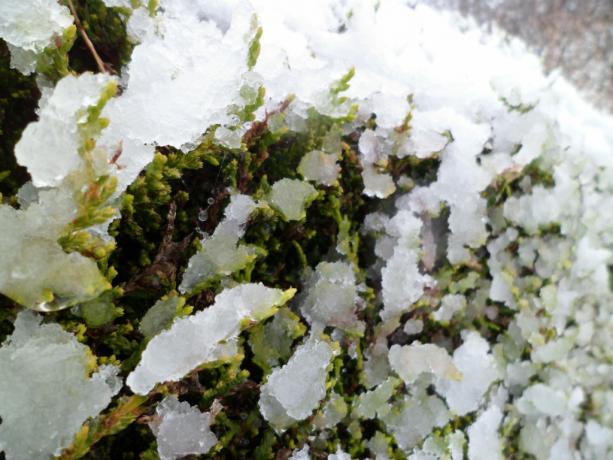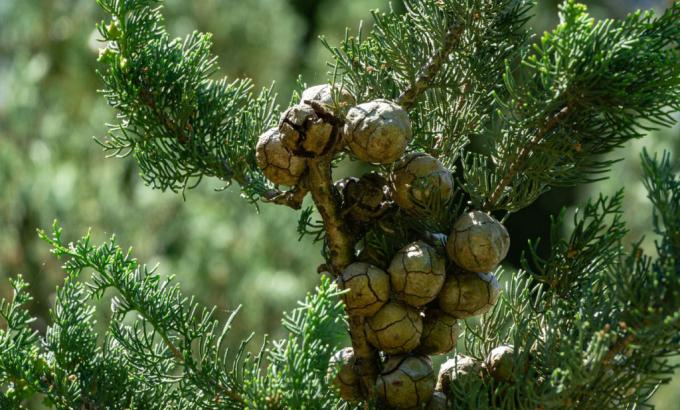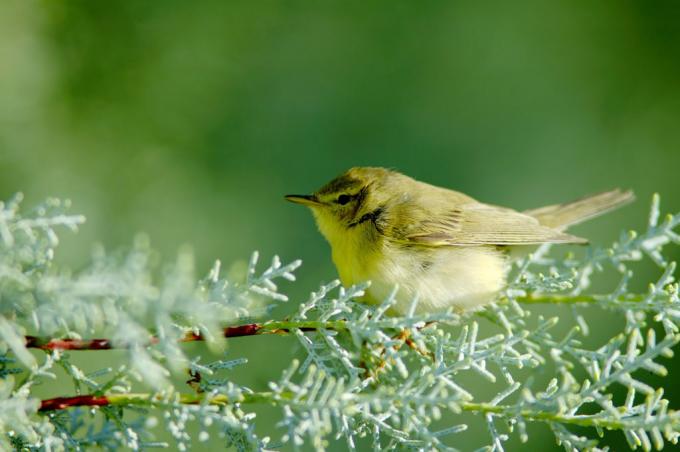Cypresses spread the holiday mood. Here you will find the best cypress species and what to consider when planting and caring for Mediterranean plants.

contents
- Cypress: origin and characteristics
- Cypress species and varieties
- Buy cypress trees
-
Planting cypress trees
- The perfect location for cypress trees
- The correct approach to planting cypress trees
- Plant cypresses in the pot
-
Maintain cypress trees
- Water cypress trees
- Cutting cypress trees
- Fertilize cypress trees
- Hibernate cypresses
- Propagate cypress trees
- Are cypress trees poisonous?
Cypress: origin and characteristics
The epitome of every Tuscany landscape are the towering cypress trees that line streets and paths or set accents between Mediterranean stone houses. But not only here are the plants at home. Cypress species are also found in other warm areas of the northern hemisphere. They can be found especially in Asia, but also in northern Africa and in warm regions of North America. At least twelve million years ago the plants were even native to today's Germany, but the Ice Age knew how to prevent this. In the meantime, cypresses are becoming more common again in this country, because many people long for the Mediterranean flair. On top of that, the evergreen coniferous plants provide excellent protection from prying eyes.
Cypress species and varieties
At least 16 cypress species are known worldwide, but only a few of them are cultivated as ornamental plants in Central Europe. Not all species are sufficiently winter hardy and humidity and precipitation are also limiting factors. Very special species are therefore rarely found in stores. We introduce you to the most common species that can also be kept in this country:
- Mediterranean cypress trees (Cupressus sempervirens) are probably the best known of all cypress trees. It is they who shape the landscape of the Mediterranean Sea and Tuscany. Their columnar growth shape makes them extremely distinctive landscape elements. Unfortunately, they are not particularly frost-resistant, as temperatures below -5 ° C over a long period of time can lead to serious damage.

- Leyland cypress trees (Cupressocyparis leylandii) are made for beautiful and dense hedges. The robust plant is a hybrid of Nootka false cypress (Xanthocyparis nootkatensis) and Monterey cypress (Cupressus macrocarpa). Thus, the Leyland cypress is not a full-flowered cypress in the strict sense of the word, as one of the mother plants is a false cypress (Chamaecyparis) is. But that doesn't matter, because it is wonderfully suitable for gardens and grows extremely lush with up to one meter per year. This species can also survive cold winters without any problems. Leyland cypresses are offered in yellow or green. Depending on your taste, you will surely find the right one here.
- the Cashmere cypress (Cupressus cashmeriana) comes from Bhutan. In Tibet and Nepal it is often planted in front of temples. Its blue-green, scaly leaves hang down from the branches, which gives it a beautiful overall appearance. However, this species is not winter hardy in our latitudes and is therefore rarely found.
- the Yunnan cypress (Cupressus duclouxiana) comes from the mountain forests of China, where it occurs up to an altitude of over 3000 meters. Despite the fact that the species is often used as an ornamental plant in this country, it is only partially winter hardy, -12 ° C is the absolute minimum that the Yunnan cypress can tolerate.

- Monterey cypress trees (Cupressus macrocarpa) enjoy worldwide popularity. They are often found in the gardens of New Zealand and on the American coast, but can also be seen here and there. Their frost tolerance is between -6 and -12 ° C. In harsh climates, the plants can be led to bizarre shapes by violent winds. The cultivar ‘Goldcrest‘Is often referred to as the indoor or golden cypress because its leaves shine in a rich golden green. It is not winter hardy, but it is ideal as a houseplant.
- Incidentally, a suitable alternative to cypress trees is the much more cold-tolerant ones False cypress trees (Chamaecyparis). Apart from the slightly flatter leaves, they look confusingly similar to cypresses.
Buy cypress trees
Choosing a favorite from the different types is not always easy. It is essential to keep an eye on winter hardiness and vigor. Because not every species is suitable for a hedge or a topiary. Even with the choice of the individual, there are a few things that you should pay attention to when making a purchase. Tips on Buying cypress trees get here.

Planting cypress trees
Real splendid specimens soon develop from small cypresses. Keeping your distance is the motto when planting the crop. You should therefore keep a distance of at least one meter from your neighbors due to the increase. When planting hedges, of course, sufficient plant spacing is also required. 50 centimeters should be the minimum here.
In addition to the distances, stability is also of great importance. Mediterranean cypresses in particular (also called column cypresses) are very tall and should therefore be carefully and firmly planted.
The perfect location for cypress trees
As inhabitants of warm and sunny places on earth, cypresses prefer a sunny to partially shaded location. You should also attach particular importance to protection from the wind. Most cypresses are not very hardy, but a sheltered location - for example near a wall - is of great use against cold winds. The plants like to stand with their feet in sandy humus soil, which provides many nutrients, but is also permeable to water. A slightly acidic pH value between 5 and 6 is optimal. Our peat-free one is ideally suited for this Plantura organic universal soil. Not only does it provide your cypress trees with nutrients, but it also promotes healthy soil life.
Unfortunately, even under these conditions, not all regions are suitable for all cypress species. There are few problems with Leyland cypresses, but Mediterranean cypresses in particular should only Planted in mild regions such as many places in North Rhine-Westphalia or in wine-growing regions will.
The correct approach to planting cypress trees
- Only plant young plants from a height of one meter, as they are then significantly less sensitive to frost
- Cypress trees can be planted between September and May
- Dig a large hole
- Fill the lower layer with loose excavation; possibly add a little sand or gravel to increase the water permeability
- Take the root ball out of the pot and loosen it up a little by hand
- Place the root ball in the hole in the ground and fill the hole with excavated material
- Press the soil lightly and water the cypress
- It helps to spread a layer of bark mulch around the crop so that the soil does not dry out as quickly

Plant cypresses in the pot
Keeping the plant in a pot is a good alternative when the region is too cold to plant the long-awaited cypress. This will allow you to move the plant to a suitable location over the winter. Planting in a tub is based on the same principles as planting outdoors. In addition, a layer of gravel is recommended as drainage at the bottom of the pot. It is also very important that the pot is of sufficient size, otherwise column-shaped cypress trees can easily tip over. A large pot also has the advantage that you have to water a little less, as more water can be stored in the pot.
Maintain cypress trees
Proper care is rewarded with cypress trees with green leaves all year round. They are not even very demanding in terms of care. If the location is the right one, you don't really need anything else - except maybe a little water on some days and protection from the cold in winter if necessary. Most of the effort is probably caused by the annual pruning. Apart from that, cypresses are extremely relaxed plants for the house and garden. However, potted plants always need a little more attention than planted specimens.
Water cypress trees
Depending on the species, cypress trees need sufficient water. Monterey and Yunnan cypresses in particular are used to moisture. A layer of bark mulch prevents too much water from evaporating and keeps the soil moist. Cypress trees usually get enough water outdoors. Only in dry summers and also winters should you try the watering can from time to time.
Of course, cypresses in winter quarters should not dry out either. Make sure that the soil remains slightly moist, but not wet either.
Cutting cypress trees
One of the main characteristics of cypress trees is their vigorous growth. The pruning ensures that the plants remain compact and do not become bald or fall victim to snow breakage. Depending on the species, the versatile plants can even be trimmed as a hedge or skillfully transformed into shapes. A mild day in October is ideal for cutting. Like yours Cut cypress properly, you can read more about it here.

Fertilize cypress trees
In spring, every cypress is happy to have a generous portion of fertilizer. It doesn't matter if it's compost, manure or ours Plantura organic universal fertilizer is, in any case, the cypress tree comes out so well over the year. Alternatively, you can of course also use mineral fertilizers and even various home remedies. Everything you need to know about the topic Fertilize cypress trees find out here.
Hibernate cypresses
Cypresses come from the warmer climates of the world. For this reason, not all species are winter hardy. However, some like the Leyland cypress are sufficiently frost-resistant and survive the winter outdoors without protection. In the case of more sensitive species such as the Monterey cypresses and young cypresses in general, a light-colored fleece helps against too low temperatures. You can use this to wrap the tree when there is a threat of severe night frosts.
Cypresses in the tub must also be protected with bamboo mats or the like to prevent the root ball from freezing through. Wrap the mats generously around the pot and also place a mat under the pot.
If you have given a room cypress (Monterey cypress) a place in your living room, you should move it around during the cold months. The plant needs its hibernation and then feels comfortable in a cool place at 5 to 10 ° C. However, since it also needs sufficient light in winter quarters, a cold house or a cool corridor with a window is perfect.
Propagate cypress trees
Although cypress trees are known for their abundant growth, growing them is a tedious endeavor. They germinate very slowly and the cuttings also take many years to become ripe for the garden.

- Propagate by seeds: Cypresses are separate sexes, so the plants have male and female flowers. A cone that bears the seeds then only develops from fertilized female flowers. But for these to germinate, the cones have to mature on the plant for several years, but at least two. And then it gets exciting. Since cypresses come from warm regions with a relatively high risk of forest fires, they have adapted. So that new cypresses can quickly gain a foothold after a devastating fire, the cone only opens when it is exposed to extreme heat. This ensures that numerous seedlings will grow immediately after a fire. In order to get to the seeds, you should place the cone on a warm heater until it opens. The sowing takes place in ordinary potting soil. At around 10 ° C and with a moist substrate, the young plants develop after a few months. However, it will take many years for them to reach a suitable size.
- Propagate by cuttings: Propagation by cuttings is a little faster, but not significantly. In spring, cut a woody branch about ten centimeters long from the tree. Then break off any side boxes in the lower part of the cutting on the branch. This is where the roots will develop later. Now you can stick the cutting in moist potting soil. A transparent bag put over it helps that the earth always stays nice and moist. It is best to pull several cuttings at the same time, as not all of them often become something.
Are cypress trees poisonous?
When cutting cypresses, you will be greeted by the spicy scent of cypress. It is caused by the poisons stored in the plant. Although these have a medicinal effect in low doses, they are poisonous for humans and animals when consumed. Therefore keep grazing animals and rodents away from the plant. You should also exercise caution with young dogs, because they like to gnaw on anything that gets in their way.

You should not leave small children unattended near a cypress tree. It is best to teach your children early on that cypress trees are poisonous.
